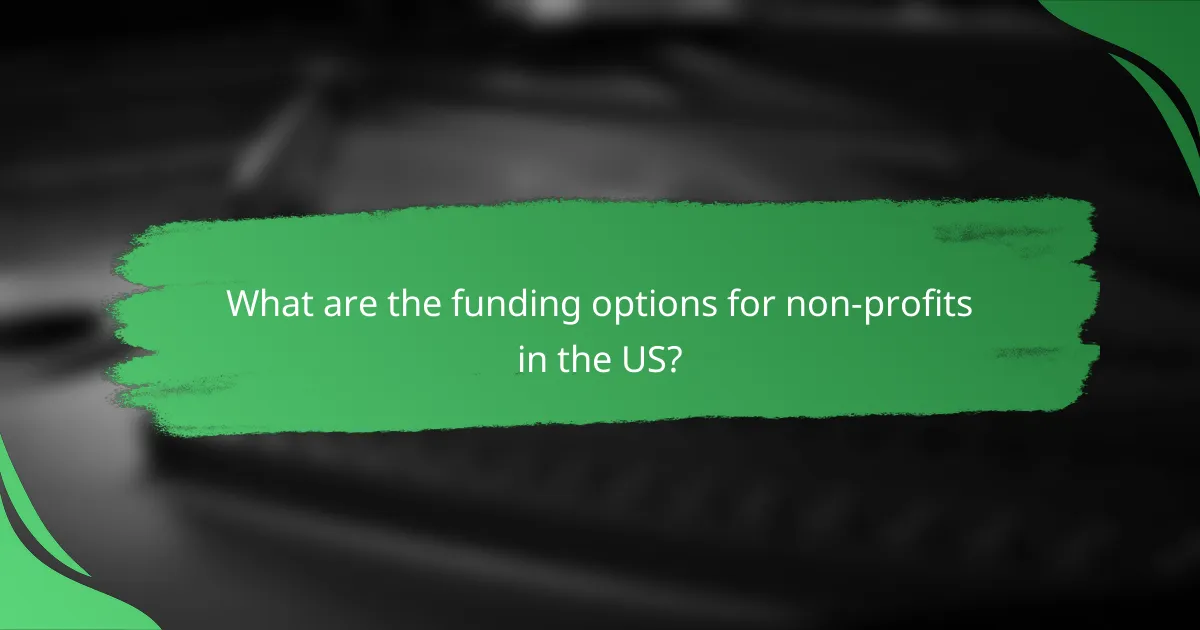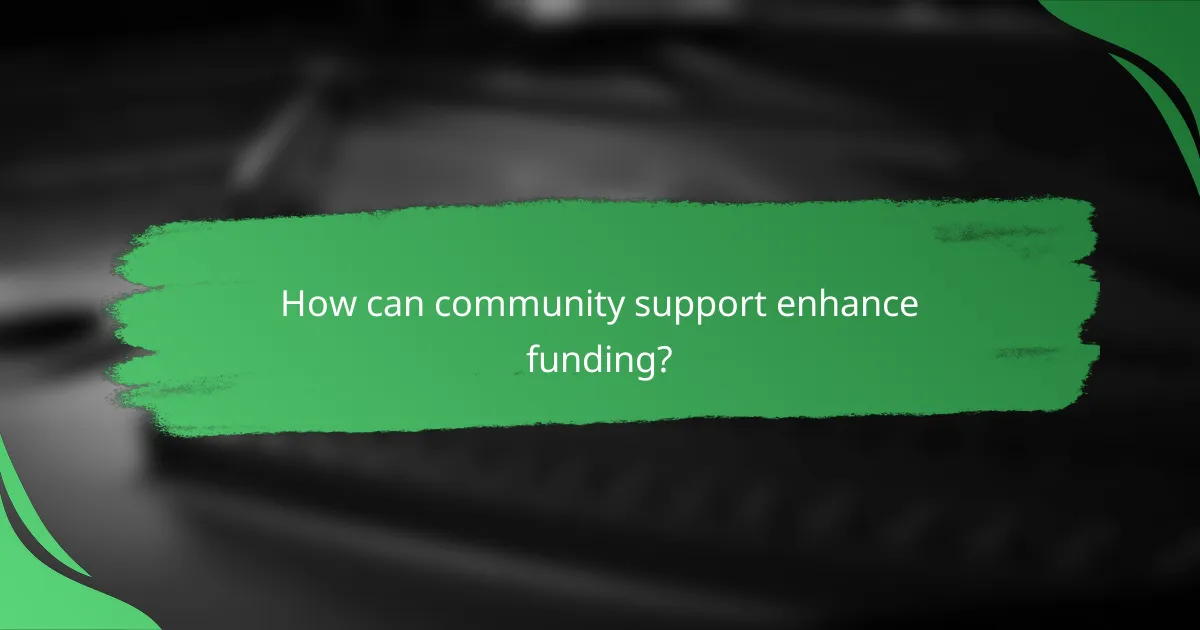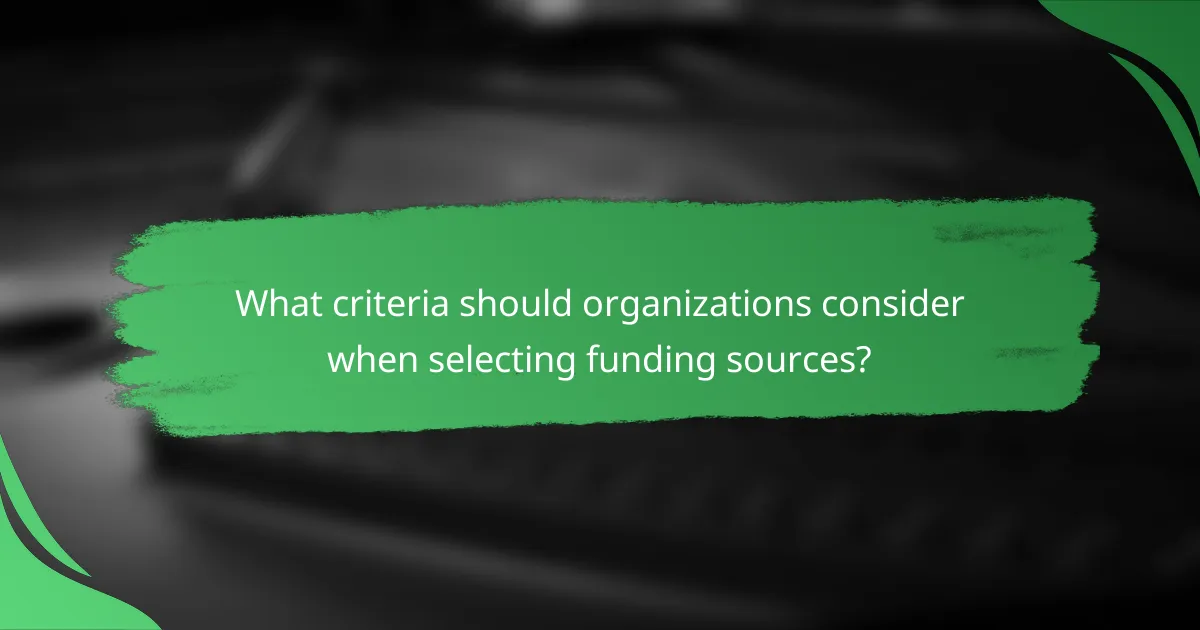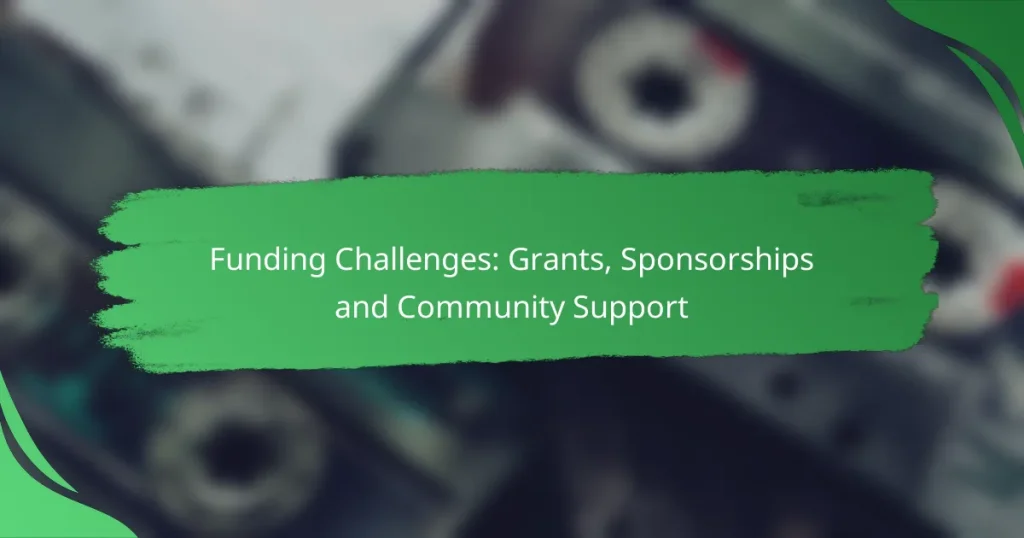Funding challenges are a significant concern for non-profits, which often rely on a combination of grants, sponsorships, and community support to sustain their operations. Understanding the intricacies of each funding source is essential for organizations to effectively navigate the landscape and secure the necessary resources to fulfill their missions. By crafting compelling proposals and building strong relationships with potential funders, non-profits can enhance their chances of success in obtaining financial support.

What are the funding options for non-profits in the US?
Non-profits in the US have several funding options, including grants from federal agencies, private foundation sponsorships, and community fundraising initiatives. Each option has unique requirements and benefits that organizations should consider to effectively support their missions.
Grants from federal agencies
Federal grants are a significant source of funding for non-profits, often aimed at specific projects or initiatives. Organizations must apply through a competitive process, demonstrating how their work aligns with federal priorities and regulations.
Common federal grant sources include the National Endowment for the Arts (NEA) and the Department of Health and Human Services (HHS). Non-profits should be prepared to provide detailed budgets, project proposals, and performance metrics to secure these funds.
Private foundation sponsorships
Private foundations offer sponsorships that can provide substantial financial support for non-profits. These foundations often focus on specific causes, such as education, health, or the arts, and have their own application processes.
To successfully obtain sponsorships, non-profits should research foundations that align with their mission, tailor their proposals to meet specific foundation interests, and maintain relationships with foundation representatives. Networking and demonstrating impact are crucial for ongoing support.
Community fundraising initiatives
Community fundraising initiatives involve engaging local supporters to raise funds through events, campaigns, or online platforms. This grassroots approach can foster a strong sense of community and loyalty towards the non-profit’s mission.
Effective strategies include hosting events like charity runs, auctions, or benefit concerts, as well as utilizing crowdfunding platforms. Non-profits should focus on building relationships with donors, clearly communicating their mission, and showcasing the impact of contributions to encourage ongoing support.

How can organizations secure grants effectively?
Organizations can secure grants effectively by understanding the grant landscape, crafting strong proposals, and fostering relationships with grantors. A strategic approach increases the chances of obtaining funding and ensures alignment with grantor priorities.
Research grant opportunities
Identifying suitable grant opportunities is crucial for successful funding. Organizations should explore federal, state, and local government grants, as well as private foundations and corporate sponsorships. Online databases like Grants.gov or Foundation Center can help streamline this research.
Consider the specific eligibility criteria and focus areas of each grant. Some grants may prioritize certain demographics or project types, so aligning your organization’s mission with these priorities can enhance your chances of success.
Develop a compelling proposal
A well-crafted proposal is essential for securing grants. Start by clearly outlining your project’s goals, objectives, and expected outcomes. Use data and evidence to support your claims, and ensure that your budget is realistic and aligns with the proposed activities.
Tailor your proposal to the specific grantor’s guidelines and preferences. Highlight how your project addresses their funding priorities and contributes to the community. Including testimonials or case studies can also strengthen your case.
Build relationships with grantors
Establishing strong relationships with grantors can significantly improve your chances of securing funding. Attend networking events, workshops, and informational sessions hosted by grantors to learn more about their priorities and funding processes.
Maintain open lines of communication with grantors throughout the proposal process. Follow up on submissions and express gratitude for their consideration. Building trust and rapport can lead to future funding opportunities and collaborations.

What role do sponsorships play in funding?
Sponsorships are crucial in funding initiatives by providing financial resources and enhancing brand visibility for companies. They allow organizations to support events or projects while gaining marketing exposure and community goodwill.
Brand visibility for sponsors
Sponsorships offer brands a unique opportunity to increase their visibility among target audiences. By associating with events or community projects, sponsors can showcase their commitment to social responsibility and engage with potential customers directly.
Effective sponsorships often include branding on promotional materials, event signage, and digital platforms, ensuring that the sponsor’s name is prominently displayed. This visibility can lead to increased brand recognition and loyalty over time.
Financial support for events
Financial backing from sponsors can significantly reduce the costs associated with organizing events. This support can cover venue rentals, marketing expenses, and other logistical needs, allowing event organizers to allocate resources more effectively.
In many cases, sponsorships can provide funding ranging from a few hundred to several thousand dollars, depending on the scale of the event and the sponsor’s budget. This financial assistance can be pivotal in making events feasible and successful.
Long-term partnerships
Building long-term partnerships with sponsors can lead to sustained funding and mutual benefits over time. These relationships often evolve into collaborations that enhance both the sponsor’s brand and the event’s reputation.
Organizations should focus on nurturing these partnerships by maintaining open communication and demonstrating the value sponsors receive. Regular updates on event impact and audience engagement can help solidify these connections and encourage ongoing support.

How can community support enhance funding?
Community support can significantly enhance funding by fostering local engagement and creating a network of advocates for a cause. This support can lead to increased visibility, resources, and financial contributions from various stakeholders.
Engaging local businesses
Engaging local businesses can provide essential financial backing and resources for community projects. Businesses often seek to enhance their community image and can offer sponsorships, donations, or in-kind support.
To effectively engage businesses, consider hosting networking events or informational sessions that highlight the benefits of partnership. Building strong relationships can lead to ongoing support and collaboration.
Creating volunteer-driven campaigns
Volunteer-driven campaigns can mobilize community members to contribute time and effort, reducing costs and increasing outreach. These campaigns can take various forms, such as fundraising events, clean-up drives, or awareness initiatives.
To maximize impact, clearly define roles and responsibilities for volunteers. Providing training and resources can enhance their effectiveness and foster a sense of ownership in the campaign.
Utilizing social media for outreach
Social media is a powerful tool for outreach, allowing organizations to connect with a broader audience quickly. Platforms like Facebook, Instagram, and Twitter can be used to share updates, promote events, and engage with supporters.
To leverage social media effectively, develop a content strategy that includes regular posts, interactive content, and calls to action. Engaging visuals and storytelling can help capture attention and drive community involvement.

What are the challenges in obtaining funding?
Obtaining funding can be difficult due to various obstacles, including competition for resources, complex application processes, and economic fluctuations. These challenges can hinder organizations and projects from securing the financial support they need to thrive.
Competition for limited resources
Many organizations vie for the same funding sources, making competition fierce. Grants, sponsorships, and community support often come from a finite pool, leading to a situation where only the most compelling proposals receive backing.
To stand out, applicants should clearly articulate their mission, demonstrate impact, and showcase community engagement. Tailoring proposals to align with funders’ priorities can significantly enhance chances of success.
Stringent application processes
Funding applications frequently involve detailed requirements and lengthy documentation, which can be daunting. Many grant applications require specific formats, extensive data, and supporting materials, making it essential for applicants to be meticulous and organized.
To navigate these processes effectively, applicants should create checklists of required documents and deadlines. Seeking feedback from peers or mentors can also help refine proposals and ensure compliance with funder expectations.
Economic downturn impacts
Economic downturns can lead to reduced funding availability as organizations tighten budgets and prioritize essential expenditures. During such times, philanthropic contributions and sponsorships may decline, further complicating funding efforts.
Organizations should diversify their funding strategies to mitigate these risks. Exploring alternative funding sources, such as crowdfunding or partnerships, can provide additional financial stability during challenging economic periods.

What criteria should organizations consider when selecting funding sources?
Organizations should consider alignment with their mission, the funding amount and duration, and the reporting requirements when selecting funding sources. These criteria ensure that the funding not only supports immediate needs but also aligns with long-term goals and operational capabilities.
Alignment with mission and values
Choosing funding sources that align with an organization’s mission and values is crucial for maintaining integrity and focus. Funding from sources that share similar goals can enhance credibility and foster stronger partnerships. For example, a nonprofit focused on environmental conservation should prioritize grants from organizations that support sustainability initiatives.
Organizations should evaluate potential funders’ missions and values by reviewing their past projects and funding history. This can help identify whether the funder’s interests align with the organization’s objectives, ensuring a harmonious relationship.
Funding amount and duration
The funding amount and duration are essential factors to consider, as they directly impact project planning and sustainability. Organizations should assess whether the funding will cover the entire project or just a portion, as well as how long the funding will last. For instance, a grant that provides funding for three years may allow for more comprehensive project development compared to a one-time donation.
It’s also important to consider the total cost of the project and how much of that can realistically be covered by the funding source. Organizations should create a budget that outlines all expenses and compare it against the funding amount to avoid shortfalls.
Reporting requirements
Understanding the reporting requirements associated with funding sources is vital for compliance and effective management. Different funders may have varying expectations regarding progress reports, financial statements, and outcome evaluations. Organizations should clarify these requirements upfront to ensure they can meet them without straining resources.
Additionally, organizations should consider the administrative burden of reporting. If the reporting process is overly complex or time-consuming, it may detract from the organization’s ability to focus on its mission. A simpler reporting structure can often be more beneficial, allowing for greater focus on program delivery rather than paperwork.


